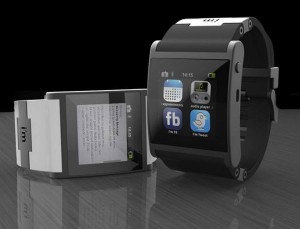Sales of so-called “smart watches” will surge from 1 million to 36 million in five years, according to a speculative new report from Juniper Research. But whether that defines “success” remains an open question.
Yet despite the frenzy of expectation around the rumoured Samsung Gear and Apple “iWatch,” even Juniper acknowledges smart watches “will only appeal to a niche demographic when compared to tablet and smartphone for example and hence the market potential will be comparatively limited.” There are two reasons for that limitation.
One is that the utility and even usability of smart watches hinges on their wireless connections with companion smartphones or tablets. Another is that most of the apps touted for the smart watches appeal to a relatively small subset of consumers, such as heart rate monitors and calorie counters for fitness enthusiasts.
The full market study is available only for purchase, but Juniper posted a “white paper” that summarizes some of conclusions.
Juniper defines a smart watch as “a smart wearable appcessory that can be worn on a user’s wrist, offering a range of smart functionalities in conjunction with an external platform, such as the smartphone or tablet.” Those functions include displaying call, text and email alerts, accessing stock and weather information or “any fitness, sports or commerce applications such as heart rate monitoring, payments or ticketing.”
One category of smart watch is what Juniper calls the “dashboard/console watch,” which is simply a “dumb terminal” acting as a display for information and data from another companion device. One example is the CooKoo watch, with the CooKoo Connected App for iOS. It uses Bluetooth 4.0 LE wireless technology to connect with Bluetooth SMART READY devices including iPhone 5, iPhone 4S, iPad mini, and 3rd, 4th, and 5th generation iPads.
The CooKoo displays incoming calls, missed calls, Facebook messages and posts, Twitter mentions, Google Voice SMS, email notification and more. Press a button and you can check-in to Facebook, remotely snap photos or record video, and control music played on your phone or tablet, and tag your location on the CooKoo Connected App map.
By contrast, according to Juniper, “multi-function” smart watches can do a bunch of things on their own, in addition to working with the phone or tablet. Juniper didn’t give an example but the Pebble E-Paper Watch, a Kickstarter darling, is certainly one, offering “beautiful downloadable watchfaces and useful internet-connected apps,” according to the website spiel. “Pebble connects to iPhone and Android smartphones using Bluetooth, alerting you with a silent vibration to incoming calls, emails and messages.” Another is the Italian-designed i’m Watch.
The smart watch booster site, SmartWatchNews, recently posted its list of the “Top 5 Smart Watches 2013.” But the mini-reviews seem unintentionally to damn with faint praise. “We feel that, although the Pebble Smartwatch [ranked number 1] is your best choice right now, it is still an incomplete product,” the post concludes. “We base this statement largely upon the complete lack of useful software.” And probably the fact that you can only pre-order it.
The i’m Watch was No. 3. “The problem with this smartwatch, like most of the contenders, is that the firmware and software just feel unfinished and incomplete,” SmartWatchNews concluded. “However, this shortcoming can be easily remedied should the much need updates be released.”
The Juniper study suggests that mobile payments may be one way to broaden the market for, and use of, smart watches. Shipments will be driven, Juniper predicts, “by a new multi-function segment capable of performing an array of additional functionalities such as tracking fitness and sports activities, payments or ticketing….”
Mobile payments and probably ticketing are being driven by advances in several areas, but one Juniper notes is near field communications or NFC. But NFC poses special challenges in something as small as a watch.
NFC operates at a very low frequency, around 13.56 MHZ, as this post at AntennaTheory.com explains. The antenna for such a chip actually acts more like an inductor: “If the magnetic fields from one inductor pass near another inductor, an induced current will exist within the second inductor. This is contactless energy transfer – exactly what NFC requires,” according to the post.
The result is that NFC antennas take up a lot of space. “In general, the larger the inductance of the antenna can be made, the better it will perform,” according to AntennaTheory. “Hence, NFC antennas are often simply loops of wire, occupying as much surface area as the device allows.” To illustrate, here’s a photo of the NFC antenna – a wrapped coil of wire – used in the Google Nexus smartphone by Samsung. Cleverly, it was mounted on the back of the battery, and covers nearly all of it, under a thin plastic back cover.
New materials are being used for antenna, such as very thin sheets of ferrite instead of copper wire. One example is the ferrite sheet antenna announced in February 2013 by Pulse Electronics’ mobile division. “Pulse’s thinner NFC antenna sends and receives clear signals even when installed in a handset in close proximity to the battery or metal housing,” according to the press release. But the sheet is still 35 x 50mm in size, or 1.37 x 1.90 inches. That will make for a big watch.
There are even indications that the age group considered most receptive to smart watches – the Millenials born from 1981 to 2000 – actually isn’t. A story at Phys.org carried the headline “Smart watches might not fit millennials’ needs, expert says.”
“A lot of the millennial behavior is transitory,” said Jeffrey Cole, director of the Center for the Digital Future. “But as people age, they still are not wearing watches, and we’ll begin to find out next month if that behavioral change is transformational.” Samsung is expected to release its Gear smart watch in September.
The center is affiliated with the USC Annenberg School for Communication and Journalism, which has been tracking one group of people for 13 years, according to the Phys.Org post by Paresh Dave.
“The results, which fall in line with other market research surveys, show little interest in devices such as Google Glass, Nike’s FuelBand health monitor, the Fitbit activity tracker and smart watches among millennials. About 3 percent of respondents are using smart watches, Cole said.”
According to Cole, “everyone’s starting to dig in their heels against privacy intrusions and the blurring lines between work and play. Having a talking, tracking and texting watch isn’t about to make things easier for consumers.”
Apple may be trying to do just that. Rumors about an “iWatch” have been swirling since early this year. Apple has made trademark filings for “iWatch” in Japan, Russia and Mexico, at least. Most recently, Apple apparently has hired fitness industry consultant Jay Blahnik, who helped launch Nike’s FuelBand wearable, and create an online community around FuelBand’s data and apps. who played a key role in the development of the Nike+ FuelBand, a wearable with sensors and apps that link with iOS devices and the Nike+ online community.
Reporting on this, AllThingsD’s John Paczkowski quoted Apple CEO Tim Cook’s comments about wearable from earlier this year at the AllThingsD conference.
Here’s the quote: “You know I wear this, it’s the FuelBand. I think Nike did a great job with this. It’s for a specific area, it’s integrated well with iOS. There are lots of gadgets, wearables, in this space now. You’ve probably tried as many as I have, maybe even more. I would say that the ones that are doing more than one thing, that there’s nothing–this does primarily one thing, the ones that do more than one there’s nothing great out there that I’ve seen. There’s nothing that’s going to convince a kid who has never worn glasses or a band or a watch or whatever to wear one. Or at least I haven’t seen it. So I think there’s lots of things to solve in this space, but it’s an area where it’s ripe for exploration.”





